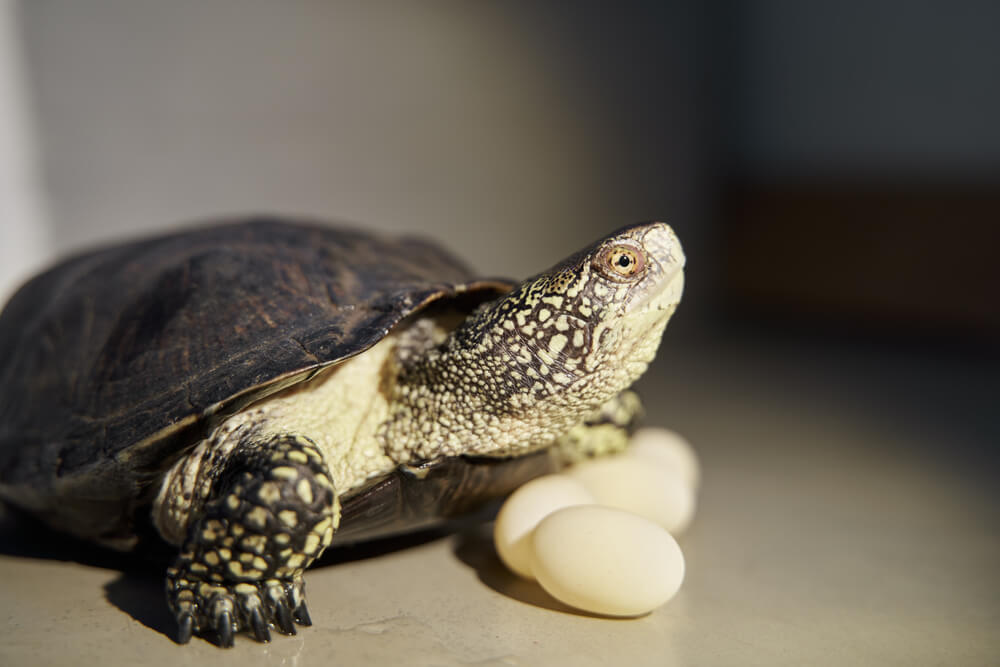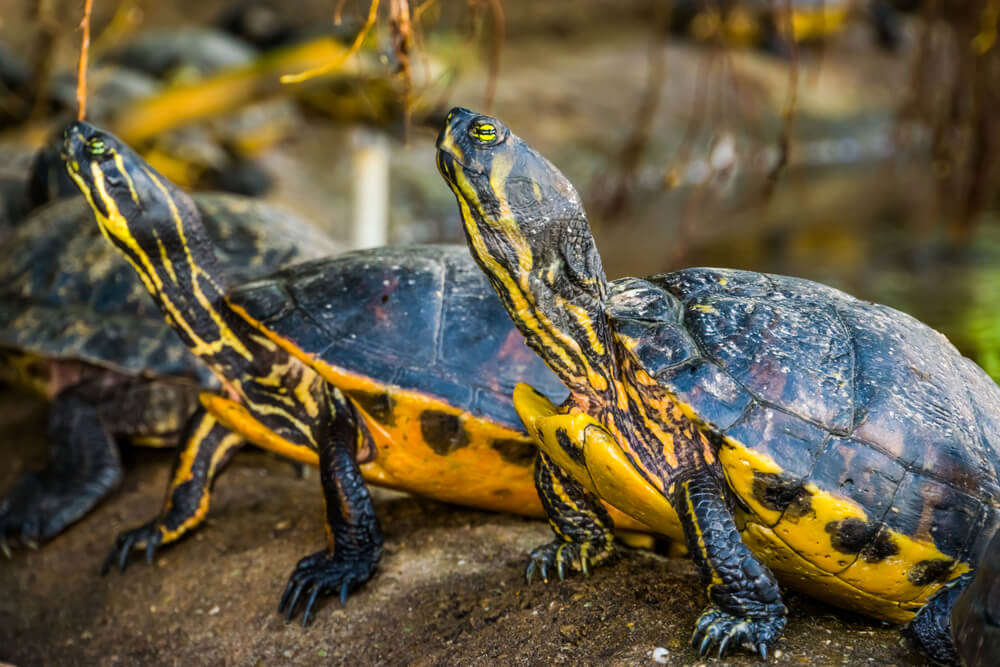Breeding turtles can be a fascinating and rewarding endeavor, especially for pet owners and hobbyists, but how to breed turtles?
It’s essential to have a good understanding of turtle biology, mating behaviors, and the ideal conditions in which these reptiles can successfully breed.
By providing an optimal environment and diligently monitoring the breeding process, you can increase the chances of successful turtle reproduction.
Turtle breeding involves several key stages, including identifying suitable mates, creating an appropriate habitat for mating, and incubating the eggs until they hatch.
To ensure the health and well-being of hatchlings, it’s crucial to be prepared for their arrival by setting up a suitable environment and providing proper nutrition.
By being proactive and knowledgeable about the various aspects of turtle breeding, you’ll be better equipped to handle any challenges that may arise throughout the process.
Key Takeaways
- Ensure you have a male and female turtle and create an optimal environment for breeding.
- Monitor the incubation process and provide appropriate care for the hatchlings.
- Be prepared for potential challenges and be well-informed about turtle breeding to achieve success.
How to Breed Turtles?

Species of Turtles
There are numerous species of turtles found all around the world. Some popular ones for breeding include red-eared sliders, box turtles, and Russian tortoises.
It’s important to understand the specific needs and characteristics of the species you plan to breed, as their requirements may vary.
Additionally, some species are easier to breed in captivity than others, so do your research before selecting a pair of turtles to breed.
Turtle Characteristics
To successfully breed turtles, you should be aware of their unique characteristics and requirements. Usually, male turtles are more colorful and outgoing than females, while female turtles tend to be larger and have a differently shaped plastron (bottom shell).
A male turtle will often have a flat or concave plastron, while a female will have a flat or convex one, providing more space for eggs.
Breeding turtles involves a combination of factors, such as appropriate habitat, diet, and environmental conditions. Turtles also require a distinct nesting area where the female can lay her eggs.
It’s important to monitor the temperature and humidity of your turtles’ environment to ensure successful breeding.
When breeding turtles, pay close attention to their behavior and health. You may notice physical and behavioral changes in gravid (pregnant) female turtles when they’re ready to lay eggs.
Keep a close eye on your turtles’ health, as reproduction can be stressful for them. Providing optimal conditions and a proper diet for your turtles will contribute to successful breeding.
Breeding Basics

Determining the Sex of Turtles
To successfully breed turtles, you should first know how to determine the sex of your turtles. Typically, male turtles are more colorful and outgoing than females.
Males have a flat or concave plastron (bottom shell), while females have a flat or convex plastron to accommodate eggs. Female turtles are typically larger than their male counterparts.
Mating Process
Once you’ve identified a male and female turtle of the same species, you can begin the mating process. Keep in mind that the time of year plays a crucial role in turtle breeding.
Make sure you follow species-specific guidelines for the optimal breeding period.
During mating, the male turtle will mount the female and use his tail to align with hers for copulation. This process may take some time, and you’ll need to keep an eye on the turtles to ensure successful mating.
After mating, monitor the female turtle for signs that she is ready to lay eggs. She may start to exhibit nesting behavior, such as digging or exploring the enclosure.
It’s crucial to provide a suitable nesting area for her, as she will need a safe and secure place to lay her eggs.
Once the eggs are laid, you will need to incubate and care for them until they hatch. It’s essential to maintain optimal temperature and humidity levels for successful incubation.
Again, follow specific guidelines for the turtle species you’re breeding.
Feeding and caring for hatchlings is the final step in the turtle breeding process. Provide the hatchlings with a balanced diet and a clean, safe environment to ensure healthy growth and development.
Optimal Environment for Breeding

Temperature
To ensure the ideal breeding conditions for your turtles, maintaining an appropriate temperature is crucial. The optimal temperature for turtle breeding ranges between 77 and 86 degrees Fahrenheit.
You can monitor the water temperature using a thermometer. If the water is not within the desired range, consider relocating your turtles to a warmer body of water or adjusting the temperature in their enclosure.
Food and Nutrition
Your turtle’s diet plays a significant role in their reproductive health. Like many other species, turtles need a balanced diet to stay healthy and fertile.
Providing them with a variety of food, including leafy greens, pellets, vegetables, and protein sources like insects, can improve the chances of successful breeding.
During the breeding season, you should pay close attention to your turtle’s nutritional needs and ensure they have access to high-quality food.
This will ensure they’re in optimal health and ready for successful reproduction.
Egg Incubation Process

Incubation Period
During the egg incubation process, you’ll need to provide the right environment for your turtle eggs. The incubation period for turtle eggs is typically around 60 days, but this can vary depending on the species and environmental factors.
It’s essential to maintain proper temperature, humidity, and substrate during this time to ensure successful hatching.
To maintain the appropriate temperature, you can use a dedicated reptile egg incubator like Hova-Bator, Zoo Med’s ReptiBator, or Juragon. These incubators are designed to keep the eggs at a stable temperature, usually between 80-86°F (27-30°C).
Monitoring the temperature with a reliable thermometer is essential to avoid fluctuations that might harm the eggs.
For humidity, choosing the right method depends on the turtle species you are breeding. If your turtle is a terrestrial species from humid region or a desert area, the low humidity method is suitable.
In this case, bird egg incubators can be used. Monitor the humidity levels with a hygrometer, aiming for around 70-80%.
Hatching
After the incubation period, your turtle eggs will begin to show signs of hatching. You may notice small cracks on the eggshells or see the hatchlings moving inside the eggs.
Once they hatch, it’s essential to handle them with care, ensuring they’re not exposed to sudden temperature changes or stress.
Most breeders place newly hatched turtles into shallow lukewarm baths to clean away any remaining membrane and allow the hatchling to hydrate.
Providing a suitable environment for your hatchlings is crucial for their growth and development. Make sure you have a dedicated area for them, with heat sources, UVB lighting, hiding spots, and plenty of fresh water available.
Feed your hatchlings a diet that meets the nutritional requirements of their specific turtle species.
Offer a variety of foods, including insects, vegetables, and commercial turtle pellets, which will ensure their growth and development are supported.
By adhering to these guidelines during the egg incubation process and hatching, you’ll set your baby turtles up for a healthy and successful start in life.
Post-Hatching Care

Once your turtles have hatched, it’s essential to provide them with proper care to ensure their survival and growth.
In this section, we’ll discuss feeding hatchlings and monitoring their health.
Feeding Hatchlings
Feeding your baby turtles is crucial for their development. In general, hatchlings require a diet rich in protein, vitamins, and minerals.
- Commercial turtle food: You can start by offering turtle pellets or flakes specifically designed for young turtles, which should be available at pet stores. These are typically formulated with the required nutrients to support your hatchling’s growth.
- Insects: Small insects like crickets, mealworms, and waxworms are excellent protein sources. Be sure to choose insects that are small enough for your hatchling to eat comfortably.
- Leafy greens and vegetables: Offer a variety of leafy greens and vegetables, such as collard greens, mustard greens, and dandelion greens, as well as shredded carrots, squash, or bell peppers. Chop them into small pieces for the hatchlings to consume without difficulty.
- Calcium supplement: It’s also important to offer a calcium supplement, such as cuttlebone or calcium powder, to support their developing shells.
Remember to offer fresh water daily and clean their habitat regularly to maintain proper hygiene.
Health Monitoring
Monitoring your hatchlings’ health during this critical stage is necessary to catch any potential issues early and ensure their well-being.
- Shell development: Keep an eye on the development of their shells. If you notice any abnormalities, such as soft or misshapen shells, it could indicate nutritional deficiencies or other health problems.
- Appetite and growth: Pay attention to their appetite and make sure they’re eating well. Underfeeding or overfeeding can result in health problems and stunted growth. Regularly measure their shell length and weight to track their progress.
- Activity level: Observe your hatchlings’ activity levels. Healthy baby turtles should be active and alert. Lethargy or unusual sluggishness may indicate illness or stress.
- Veterinary check-ups: Schedule periodic veterinary check-ups to ensure your hatchlings’ continued health. A specialized reptile veterinarian can help identify any health concerns and provide valuable advice on raising your young turtles.
By providing proper post-hatching care, including feeding and health monitoring, you’ll increase the chances of your hatchlings growing up to be strong, healthy turtles.
Potential Challenges

Breeding turtles can be a rewarding endeavor, but there are several potential challenges that you may encounter during the process.
In this section, we will discuss two primary concerns: health issues and environmental challenges.
Health Issues
Maintaining the health of your turtles is crucial during the breeding process. One important aspect to monitor is the water temperature, as turtles need warm water to breed successfully.
The ideal temperature for turtle breeding is between 77 and 86 degrees Fahrenheit. Make sure to regularly check the water temperature using a thermometer and adjust it if necessary.
Another health concern to be aware of is the risk of infection or disease. Turtles can be susceptible to various health problems, such as respiratory infections or shell rot.
Ensure your turtles are receiving proper care, including a nutritious diet, clean living conditions, and regular veterinary check-ups.
Environmental Challenges
Creating a suitable environment for turtle breeding can be a complex process. You need to provide a comfortable and spacious habitat, taking into account the specific requirements of your turtle species.
Some turtles may need a separate nesting area for laying eggs, while others may require a specific type of substrate.
It’s also important to consider the impact of breeding turtles in captivity on wild populations. Acquiring captive-bred turtles is advised to ensure that you’re not negatively impacting wild turtle populations.
Additionally, make sure to research any regulations or legal restrictions in your area regarding turtle breeding and ownership.
Overcoming these challenges requires diligence and commitment to proper care for your turtles.
Monitoring their health and creating a conducive environment can successfully breed healthy and happy turtles.
Frequently Asked Questions
What conditions are needed for turtle breeding?
In order to breed turtles successfully, there are specific conditions that need to be met. The ideal temperature for turtle breeding is between 77 and 86 degrees Fahrenheit (25-30°C).
Keeping the water temperature within this range is essential. Additionally, proper lighting, appropriate space, and a suitable nesting area are crucial for turtles to breed.
What is the process of hatching turtle eggs?
Once the female turtle has laid her eggs in a designated nesting area, the incubation process begins. The eggs are usually buried in sand or soil and should be kept moist but not overly wet.
The temperature should be maintained consistently throughout the incubation period. This period is essential for the embryos to develop properly within the eggs.
How long does it take for turtle eggs to hatch?
The duration of the incubation period varies depending on the species of turtle. Generally, it can take anywhere from 45 to 90 days for turtle eggs to hatch.
Keep in mind that the temperature during incubation plays a significant role in determining the hatchlings’ sex.
What precautions should be taken for breeding turtles at home?
Breeding turtles at home comes with responsibilities and precautions. First, ensure that you have adequate knowledge about your turtle species’ specific requirements.
Also, make sure you provide appropriate living conditions and sufficient space. Additionally, monitoring the water temperature, providing a proper diet, and creating a nesting area are essential.
A clean and stress-free environment will encourage successful breeding.
How to ensure healthy offspring in turtle breeding?
To ensure healthy offspring, it is vital to take care of the hatchlings. Maintain proper temperature, humidity, and lighting conditions. Providing hatchlings with a nutritious diet is also essential for their growth and development.
It’s crucial to monitor the hatchlings closely for any signs of illness or abnormal behavior.
What are the differences in breeding various species of turtles?
Different turtle species have unique requirements and preferences when it comes to breeding. Some turtle species lay eggs in the soil, while others prefer sand or vegetation. Mating habits and gestational periods may also differ.
Therefore, it is crucial to research and understand the specific needs of your turtle species to ensure successful breeding.














